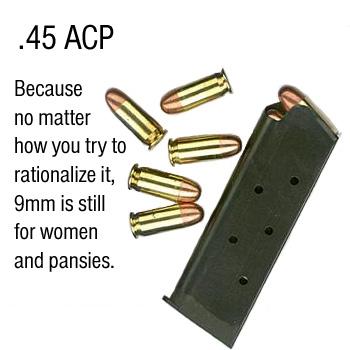|
ROCK RIVER VS WILSON
COMBAT
It's a dark and stormy
night. A heavy rain pours sheets of water across your windshield as
you pull into your driveway. In the flash from bolt of lighting you
see that the front door to your home is open and through the window
of your castle, you see the silhouette of a stranger. You exit your
vehicle and as you shut the door, you hear the crash of thunder and
the shattering of something fragile from inside your house. You open
your bag and pull out your Wilson Combat Professional. No, the Rock
River Pro Carry... you can't decide. While your are trying to decide
the bad guy escapes out the back with your Maltese Falcon. You don't
care either, because your standing there holding both guns and you
forgot the reason you pulled them out in the first place as you
admire how the rain just runs off the Professional's finish and how
the Rock River gleams menacingly when wet.
Okay, I'm stretching for
ideas here. Scrambling up a beachhead of slick rocks that have been
polished smooth by waves of articles written about custom 1911's.
What more can I say that hasn't already been said about guns just
like these?
One of the problems I'm
having with this issue's review is that both of these guns are just
too damn good. Looking at them with a critical eye, it's difficult
to pick out anything wrong with them to point out. I've got a Wilson
Combat Professional and a Rock River Pro Carry over here. The Wilson
is black and gray Commander length gun with night sights, checkering
on the front and back straps and very cool looking laminated grips.
The barrel is a bushingless bull design. The Rock River is a more
traditional 1911 with night sights, a beaver tail, and a commander
style hammer. It sports additional checkering, rosewood grips and a
Kart match grade barrel.
Both pistols have these
ramp style snag free night sights. While I'm not big on the ramp
style, night sights are probably the most important feature of any
handgun intended for serious defense use. If you have a gun that is
marketed as such, and it doesn't come with night sights... then it
is just that... marketing. That is something that I just can't
compromise on. Cough cough, HK, cough... Sorry about that, something
got caught in my throat. Excuse me. If you are going to use your
handgun in a defensive situation, most likely it's going to be after
dark or in low light. In that situation you are going to really need
to know where your front sight post is. Most sights seem to
disappear when it starts getting dim outside. A tiny little tritium
insert can make all the difference. The difference between life and
death. If your chosen carry gun doesn't have them... then plan on
getting them installed. If you are buying a new gun, order one with
the sights on them. If your shop can't get them, then go to a
different shop that can. No compromises.
I've already spent way
more money on ammunition for these two pistols than what I will make
for writing the article, and I am afraid that I'm going to have to
buy more ammo for these hungry .45's. Their empty chambers cry for
more rounds like a nest of baby birds... forever begging for more
and more... it's like a crazy Orwellian nightmare. These guns beg to
fired and I'm afraid I'm going to go broke answering their calls.
What makes these guns so
good? In a previous article about the Wilson Combat SDS pistol, I
talked about the Armor-Tuff finish. The Professional model uses the
same finish, but does it in a handsome black and gray two tone
finish. The Commander length slide makes it ideal for Concealed
Carry readers. Also, like the SDS, this gun is expensive, but it is
worth every single penny.
The Rock River has a nice
blued finish that contrasts with the gorgeous rosewood grips. The
five inch barrel gives this gun a standard “Government Model”
length. While longer than ideal, one can carry this concealed with
little extra effort. This is the traditional size of the 1911
pistol, the original cut. The way John M Browning designed it.
The 1911 is not, in my
mind, a perfect handgun. While the design is brilliant and the
product of pure genius, it has... oh man, I thought I took some heat
criticizing the HK. This is going to get me into some hot water here
with the 1911 purists. It has some parts that are less than ideal.
For example, the shortened guide rod for the recoil spring, the
plunger, and the bushing. Browning fixes these in the High Power
which came out in 1935. Wilson fixes this by using a more modern
recoil system with a full length guide rod and a bull barrel that
matches up to the slide its self instead of the bushing. This makes
for a gun that is a bit easier to field strip, while insuring
accuracy.
Another thing that has
always bothered me about 1911's is the barrel link. This was at the
time a very clever way of getting the barrel to move exactly how
Browning wanted it to move... to come back during recoil and unlock
from the slide. But it is actually a tricky part when it comes to
fitting in a new pistol and reassembling the pistol after a field
strip. The link can wear out and can lead to inaccuracy or failures
even when everything else is in perfect condition. Most pistols now
use a “Modified Browning System” which means that they get the
barrel to do everything just like how Browning wanted it to, but
without the link. One way to fix the weakest link in the chain is to
remove the chain. Both guns here use Browning's original link
system, but they do so using links made to tighter tolerances and of
better steel than was available back in the early 1900's. They are
still annoying when putting the guns back together, but this is
really my only beef with them. Once properly reassembled, one
forgets and forgives that pesky linkage.
Both guns sport wide mouth
ejection ports with the claim that the wider ports make the gun more
reliable. I'm not sure if that is exactly true, or if that has just
become the style in new 1911's. I've fired original 1911 Colts with
the smaller ejection ports and they ejected just fine for me.
However the original Colts did bite my hands. What is called “Hammer
Bite” is when some meat of the shooter's hand gets pinched by the
hammer. My shooting hand has had a couple holes punched into the
flesh because of that. Both guns here use shorter hammer style that
came out with the Commander and are thusly referred to as “Commander
Style” hammers. They also use a grip safety that is longer and wider
than the original Government Model's, these are called “Beaver
Tails” and they not only prevent hammer bites, but they feel good,
guide the hand to the holstered gun's grip, and they look better in
my opinion. Some purists do not like the beaver tails and claim to
have been never bitten by an original style government's hammer.
They also recall things like serving as crewmen aboard the Minotaur,
silent picture shows, and enjoying these new fangled electric
lights. Newer shooters have taken a lot of tips from shooting
competitions such as IPSC where a very high grip has become the
vogue and is advantageous in controlling recoil. This high grip will
get you hammer bit if your hands are even slightly “meaty” like mine
are. Both guns offer some improvements to the old 1911 platform and
are examples that are in my opinion the top of the line.
The Rock River Pro Carry
is a fantastic example of the 1911. It is elegant and refined and
offers everything that a connoisseur of Forty Fives will appreciate.
Rock River also builds some of the best AR-15 type rifles on the
planet with superior fit and finish work that will make owners of
DPMS and Bushmaster rifles want to go home and kick their dogs. The
Pro Carry is a big step up from the 1911 rat race of guns costing
$1,000 or less. You could easily purchase a second pistol for the
price difference. There are differences between guns at this level
and guns at or under the 1K mark. At this level we expect a perfect
slide to frame fit. The Pro Carry has that. They slide moves back
and forth on the rails smoothly with no tightness and no lateral
play. It bank vault solid. This is what a 1911's slide should feel
like. The barrel should have no play inside its bushing either. Some
lesser 1911's have a little bit, but not in any Rock Rivers that
I've ever seen. When the barrel and slide lock up as solid as this,
you have a good indication that the gun is going to be accurate.
This Pro Carry certainly is. They advertise a guaranty of accuracy
of 2.5 inches at fifty yards. Fifty yards is crazy for a service
gun... that's a long way out there. Two and a half inches at that
range is what most shooters do with a rifle. This is the result of
using a match grade Kart barrel and making sure the gun is built
right. I've heard some guys say that a 1911 is not an accurate
handgun. Obviously they have never fired a good one, and they have
certainly never fired a Rock River.
Initially when I first
handled this Pro Carry, I thought that the checkering on the front
strap was too sharp. I thought that this would have been too
abrasive when firing. This wasn't the case at all. The gun was in
perfect control at all times without the checkering causing any
irritation or discomfort. The more I shot the Rock River, the more I
liked it. Punching one hole groups (even with cheap ammo) actually
became mundane and eventually boring, if you can believe that. The
Pro Carry is a damn fine handgun and worthy of it's MSRP. You can
get it with a 4.25” barrel, the 5 as tested, or even with a 6”
barrel. As excellent as this 5” example is, 4.25” is ideal for our
purposes. For you connoisseurs of 1911's out there, you need to
sample one of these. I like it better than a certain Ed Brown I shot
recently that had a similar configuration... and it's less spendy
than the Ed Brown custom too. It is also more accurate than the Ed
Brown was. I'm not saying this to take down Ed Brown. Not at all.
I'm just using his guns as an example of just how good this Rock
River is. The Pro Carry is easily one of the best 1911's I've ever
fired. Try one, I dare you. You'll never look at another Kimber
again. At the gunshop where I work, we've got a large array of
1911's from Springfield, Kimber, Para Ordinance, and Smith & Wesson.
To be honest, not a single one of them hold any interest in me any
more. There is a difference in what you get for your money, and once
you shoot a Wilson or Rock River anything less is just not good
enough anymore. It's hard to describe just how or why that is, so
I'll just chalk it up to being spoiled.
The Wilson Combat
Professional did not print groups quite as tight as the Pro Carry,
but that matters little when the X-ring of your target is completely
blown out and your shot group is just one rough edged hole. The
bull-barrel configuration goes a long way in helping accuracy. The
Professional is every bit as well built as the Pro Carry. You are
not going to detect any flaws in any of the tolerances in the fit
and finish. The Professional's shorter sight radius is most likely
the cause of the slightly wider one hole shot groups. The trade off
is a gun that is easier to carry. The tighter checkering felt great
in the hand. These things added up to gun that handled with ease and
precision of Lotus Exige. In other words, it is fantastic. The gun
comes out of the leather and up onto target faster than the Rock
River and more precisely. Exactly why that is, I'm not sure. The
Professional is a remarkable pistol. As much as Wilson's SDS pistol
impressed me, the Professional impresses me just as much. Thanks to
a more traditional bull barrel, I like the Professional more. The
fact that the Professional is lower on the sticker price than the
SDS is a nice bonus.
My wife Deveni asked me
which one I liked better, the Professional or the Pro Carry. This
was a hard question. She might as well have asked me a question
about mortgage rates in Anchorage... I don't know! This brings me
back to the article's beginning. The first night I got both of these
pistols out on the range, I found myself standing at the hood of my
Bronco looking at them until it started raining on me. I stayed
there, in the rain, trying to decide. My answer was that I needed to
shoot them more. I came to that same conclusion several times since.
My conclusion is still the same today and is the reason for some
financial stress. Ammunition prices are going up like gas prices now
thanks to China buying up large quantities of metals and driving up
prices. So I guess I'm going to have to force my hand and make a
choice. Between these two handguns, I'm going to have to pick the
Wilson Combat. The reasons are the Professional's commander size
which gives it the advantage for concealed carry work. The new
Wilson magazines are also an advantage thanks to an improved
follower design that improves the function of any 1911 pistol it's
used in. If you can't get a Wilson 1911 pistol, at least make sure
you get Wilson magazines for it! The Armor-Tuff finish which comes
with a nice long warranty so you don't have to worry about babying
your investment. You can get the Professional with frames in gray
like this one, black, or OD green. Or if you like, you can even get
a Professional done up all in stainless. (A stainless Professional
with ivory grips would be to angelic for me, but would be a perfect
gun for packing on Sundays.) The gray is probably the best looking
of all the options. Once you select your color, Wilson has more for
you to try to decide on, such as your holsters and mag pouches. Good
luck with that.
Rock River Pro Carry:
$1,795.
http://www.rockriverarms.com
Wilson Combat
Professional: $ 2,175.
http://www.wilsoncombat.com



Donate
to
ogre@madogre.com via PayPal to support MadOgre.com, or God will kill a kitten.
Copyright
G H Hill 1999-2012
|











